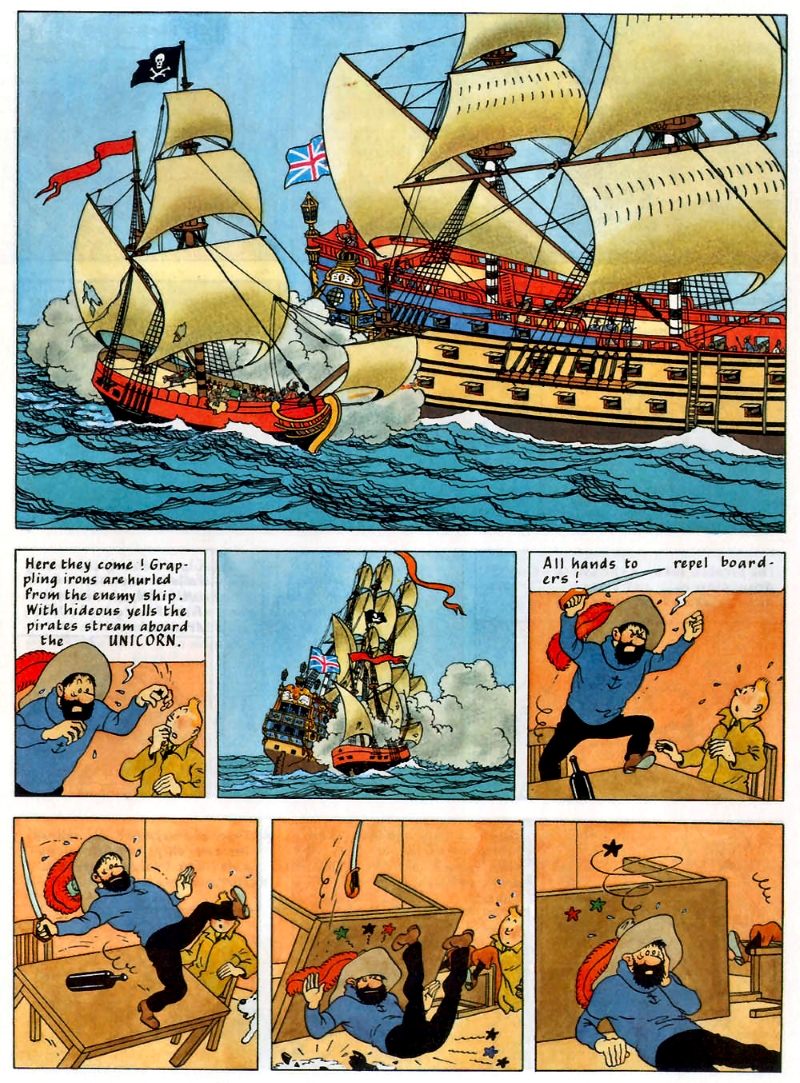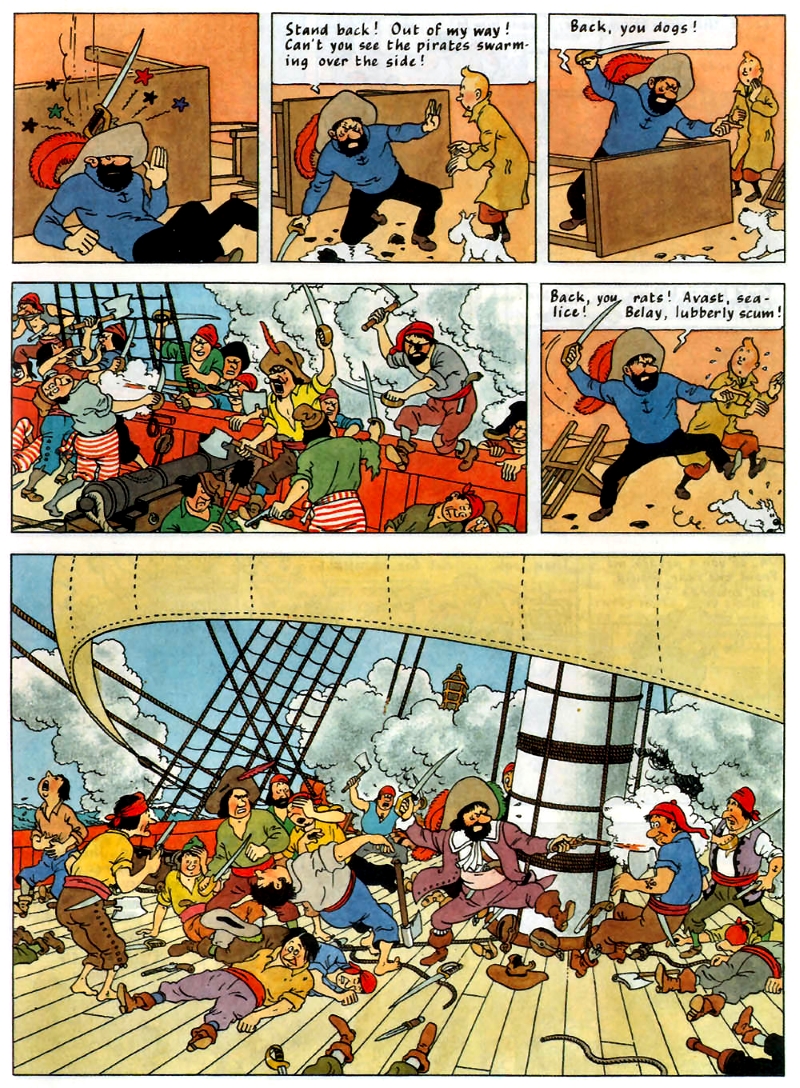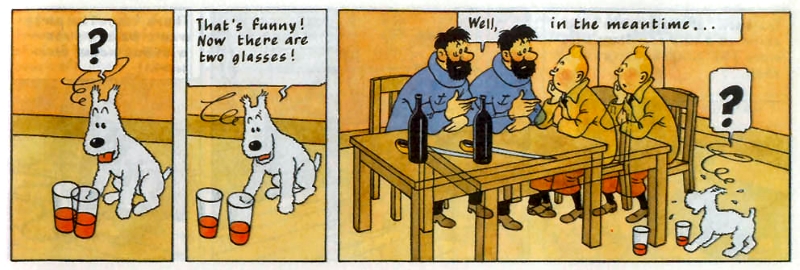The Adventures of Tintin: Reviews by Confessor
Sept 18, 2017 12:27:51 GMT -5
shaxper, Roquefort Raider, and 3 more like this
Post by Confessor on Sept 18, 2017 12:27:51 GMT -5
The Shooting Star (French: L'Étoile mystérieuse)
Original publication dates: October 1941 – May 1942
First collected edition: 1942
Author: Hergé
Tintin visits: Belgium (Brussels, Antwerp), Iceland (Akureyri), Arctic Circle.
Overall rating:




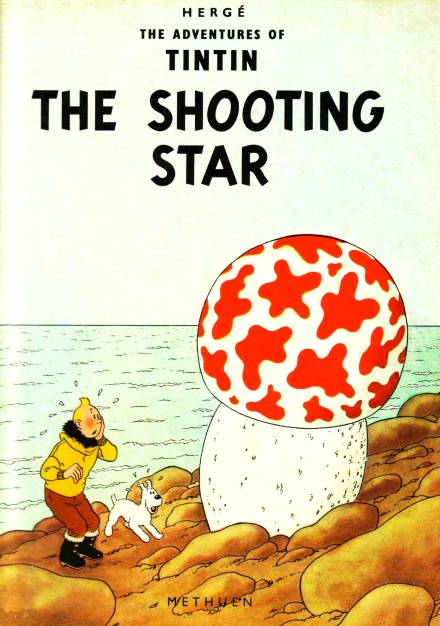
Plot summary available here.
Publisher's synopsis: "It's the END of the WORLD!" declares Professor Phostle, as an enormous star hurtles towards the earth. But he is disappointed - the star brushes past, leaving only a vast meteorite which falls in the Arctic waters. However, there is no mistake about the Professor's discovery of a valuable new metal in the meteorite; it is worth a colossal fortune, and in a hazardous search in polar regions Tintin, Snowy and Captain Haddock encounter some of their strangest adventures.
Comments: The Shooting Star (or "The Mysterious Star", as it should literally be translated) is another one of the books in The Adventures of Tintin whose cover intrigued the hell out of me as a kid. There's something wonderfully surreal about the giant red and white mushroom that Tintin and Snowy are regarding with such surprise, contrasted against the washed-out sky and sea, that just screamed "read me!" to my 10-year-old self.
The adventure was originally published daily in the pages of the popular Belgian French-language newspaper Le Soir between October 1941 and May 1942. However, when it was collected into book form in late '42, it became the first Tintin story to be published in colour and in the standard 62-page format that we are familiar with today (the earlier books in the series were all redrawn and coloured for that format later in the '40s and '50s).
The plot of The Shooting Star concerns an approaching catastrophe, in the shape of a huge meteorite hurtling towards the Earth. Thankfully, it misses our planet, but a fragment of it does break off and crash somewhere in the Arctic Ocean, prompting a race to investigate the object between two rival scientific expeditions – one of which includes Tintin, Snowy and Captain Haddock. The strange star that appears in the night sky and the oppressive heat it causes certainly make for an intriguing opening to the book. However, the meteorite's approach and the subsequent impact of part of it on Earth are depicted in a wildly unrealistic way, riddled with scientific inaccuracies (there's no mention of the tsunami that the impact would've undoubtedly caused, for instance). But to nitpick the scientific accuracy of this tale is to miss the point; it is the sense of foreboding and panic that the approaching meteor engenders in the population – and in Tintin in particular – that is of greater significance.
Given that this story was written during the darkest days of World War II, with Hergé's beloved Belgium firmly under the jackboot of Nazi occupation, it's tempting to see the doom-laden, "end of the world is nigh" atmosphere of the first third of The Shooting Star as symptomatic of the despair felt by the people of occupied Europe. This creeping sense of doom and paranoia is further heightened after Tintin visits the local observatory and learns from the astronomers there exactly what the strange star in the night sky is...

Having learned of humanity's fate, our hero wanders through the humid streets of Brussels in a daze, amid concerned and fascinated members of the public, who are quite ignorant of the impending apocalypse. Only Tintin knows what is about to happen...
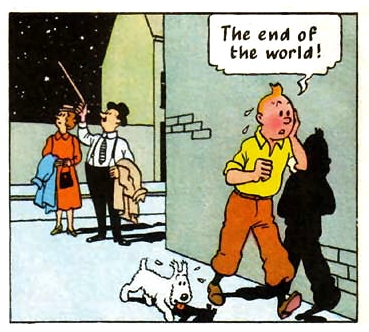

The sense of catastrophe is heightened as our hero witnesses packs of rats fleeing from the sewers and meets a deranged prophet of doom...

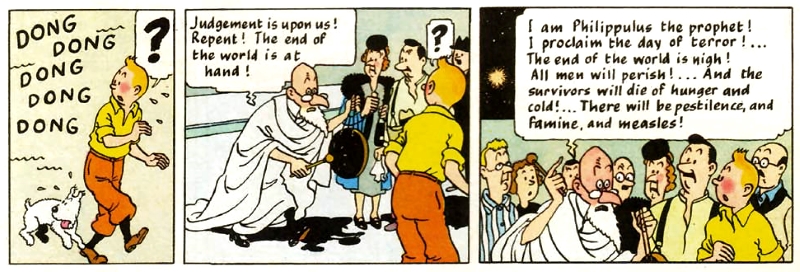
It's hard to think of another moment in The Adventures of Tintin in which our hero is so despondently resigned to his fate. Again, it's difficult not to conclude that the oppression of the Nazi regime and the bleakness of a future under the Third Reich must've had an influence on the dire mood of this book.
But then again, much of this story reads like pure escapist fantasy. It's sort of like a science fiction-based adventure, or a ripping Boy's Own yarn, with the expedition to the Arctic and exciting race for the meteorite having no discernible political content at all. Then there's the surreal, dream-like shenanigans on the surface of the meteorite "island" itself, with Tintin dodging giant spiders and exploding mushrooms!

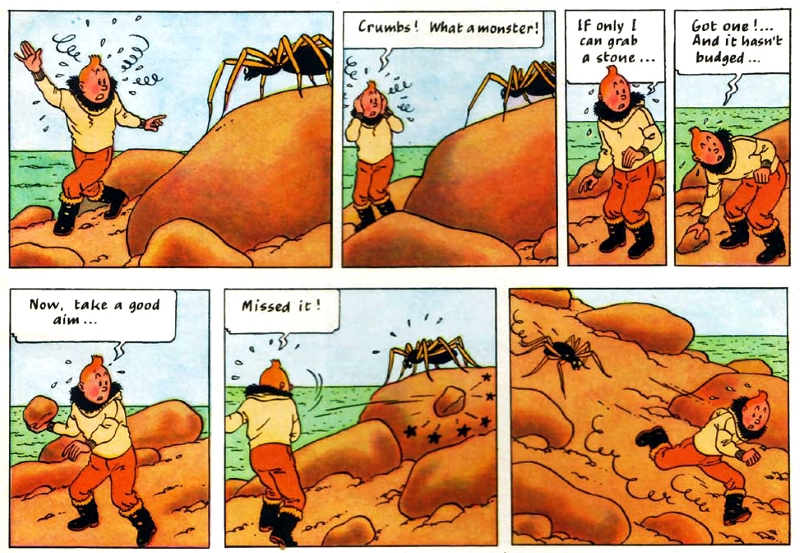
With all of these surreal, sci-fi elements and the race to the Arctic, I think that The Shooting Star could just as easily be seen as Hergé's retreat into the world of fantasy, in order to escape from the horrors of the Second World War. I get a sense of the author attempting to show that it was business as usual in the Tintin strip, while also keeping his characters away from any real world political intrigue and, instead, taking them on fantasic adventures, far removed from the realities of war. Perhaps the truth of the matter is that, for Hergé, The Shooting Star was a little bit of both: one part sombre reflection on the mood of his homeland under Nazi occupation, and one part flight into escapist fantasy.
As for the strange goings on upon the meteorite's surface, although it's never addressed in the book, I've always assumed that the giant spiders, exploding mushrooms, oversized insects and huge trees that spring into being around Tintin are caused by radiation seeping from the interstellar object, or perhaps as a result of strange, alien nutrients in the soil? Or maybe it's simply due to properties inherent in the "Phostlite" metal that astronomer Professor Phostle discovered within the meteor. Whatever the reason, it's clear that the strange, enlarged fauna and flora that appear on the meteorite are earthbound species, mutated by the meteorite itself, rather than alien creatures.
On a related note, I like how the encounter with the giant spider is foreshadowed in a scene in which Tintin looks through the Brussels' observatory telescope and sees a giant, alien spider in the midst of the blazing meteorite (although it turns out to just be a normal-sized spider that has crawled onto the instrument's lens). I'm not sure why, but this "spider in the telescope" scene is particularly memorable for me...
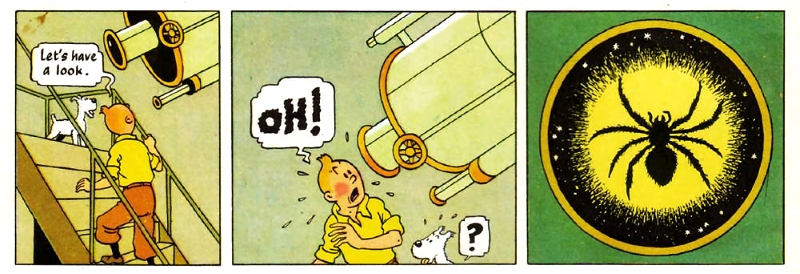
The chief astronomer at the observatory has the fantastic name of Decimus Phostle (his surname of course being the suitably academic-sounding "fossil"). Phostle is yet another in a long line of eccentric scientists that we've seen in The Adventures of Tintin. Like many other Tintinologists, I definitely view these various absent-minded or eccentric professors who pop up in the earliest years of the strip as prototypes for Professor Calculus, who we will see debut in Red Rackham's Treasure. It's as if Hergé had been desperate to introduce such a character into the series for some time, but hadn't really hit upon a scatter-brained academic that was precisely to his liking. That would, of course, change in a couple of years time, with the arrival of Cuthbert Calculus.
The Shooting Star was first translated into English in 1961 and there are several pieces of dialogue here that mark the English translation as very much a product of its time. For example, I love the quaintness of Professor Phostle sending his colleague out to buy "six penny worth of bull's eyes" (which are old-fashioned, British boiled sweets) to celebrate his discovery of a new element within the meteor. Likewise, Tintin at one point dials "Tim, the speaking clock", which was what the UK telephone clock service was called between the 1930s and 1980s, with its number of 846 corresponding with the letters TIM on the old, rotary telephone dial.
We also get the return of Captain Haddock in this adventure – the first in which he is an established cast member. I find the Captain to be much less annoying than he was in The Crab with the Golden Claws and, as a result, is a much more effective companion for Tintin too. When we first see the fiery mariner, he is apparently still "on the wagon", following Tintin having cured him of his alcoholism at the end of the last adventure. In fact, Haddock has apparently become such a model example of a reformed alcoholic that he is now the honorary president of the Society of Sober Sailors! Hergé has some fun with this, as he allows us – the readers – to glimpse a medicine cabinet in the Captain's quarters that is stuffed full with his secret whisky stash...
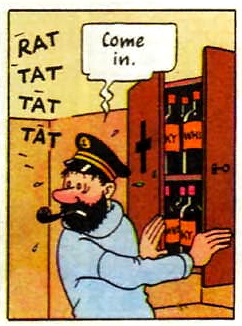
The pay off for this amusing, dark secret of the Captain's comes a few pages later, when the committee for the Society of Sober Sailors present Haddock with a bouquet of flowers on the quayside, just as his crew arrive with additional whisky supplies...

Note too that, in the top left panel in the above excerpt, we get a fleeting cameo from the Thom(p)son Twins, who are otherwise entirely absent from this story. Note too that the pair of children running in front of the bowler-hatted detectives are the stars of Hergé's other strip, Quick & Flupke.
In addition to the humour concerning Haddock's drinking relapse, there are plenty of other big laughs associated with the Captain. I particularly enjoy the panel in which the Captain sends a furious, expletive-laden radio message to the sponsors of the rival expedition and ends it with the uncharacteristically polite, "signed: Haddock"...

There are also lots of amusing moments associated with Tintin's faithful terrier, Snowy, too, such his extinguishing a lit stick of dynamite by peeing on it – which certainly shows some ingenuity on the dog's part! All in all, the ensemble cast really shine in this adventure, with only Professor Calculus, who hasn't yet been introduced, missing.
As for Hergé's art, it's again of the predictably high standard that we've come to expect, with the composition and staging in many of the panels being utterly superb. Really, by this point in his career, Hergé could pretty much do no wrong, art-wise, and he would continue to improve as well! Of particular note are the exciting and gloriously depicted storm scenes on the deck of the ship Aurora, as Captain Haddock, Tintin and Snowy fight against the elements and an attack from a rival ship...
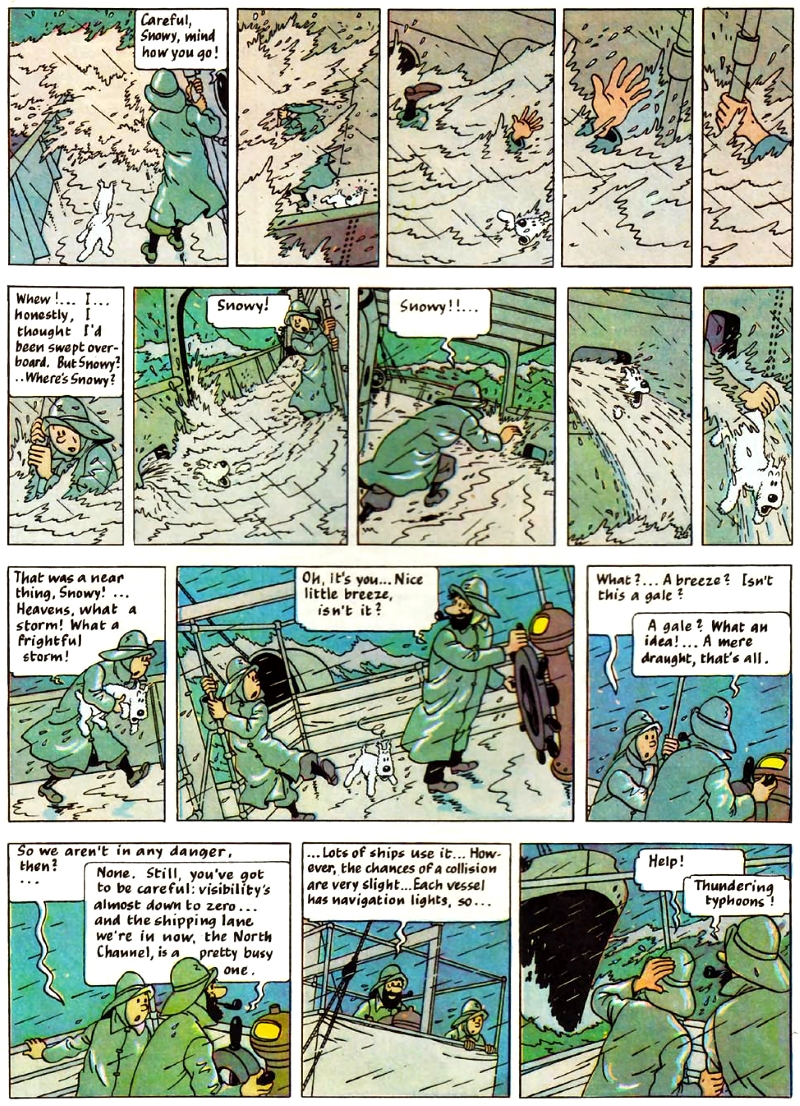
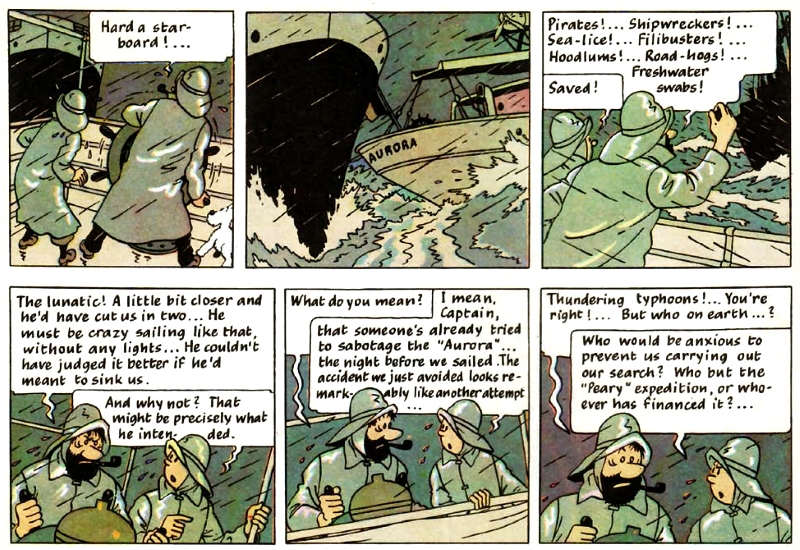
To sum up, The Shooting Star is somewhat simplistic, compared to other, recent instalments of the series, but that isn't necessarily a negative criticism. Yes, the book is a relatively straight forward adventure, but it is also extremely memorable – not least for its pessimistic, "the end is nigh" mood and the surreal, dream-like hijinks that take place on the surface of the meteorite fragment. There's an economy to the storytelling here and lots of laughs to be had, which serve to make The Shooting Star one of my favourite stories in The Adventures of Tintin.
Original publication dates: October 1941 – May 1942
First collected edition: 1942
Author: Hergé
Tintin visits: Belgium (Brussels, Antwerp), Iceland (Akureyri), Arctic Circle.
Overall rating:






Plot summary available here.
Publisher's synopsis: "It's the END of the WORLD!" declares Professor Phostle, as an enormous star hurtles towards the earth. But he is disappointed - the star brushes past, leaving only a vast meteorite which falls in the Arctic waters. However, there is no mistake about the Professor's discovery of a valuable new metal in the meteorite; it is worth a colossal fortune, and in a hazardous search in polar regions Tintin, Snowy and Captain Haddock encounter some of their strangest adventures.
Comments: The Shooting Star (or "The Mysterious Star", as it should literally be translated) is another one of the books in The Adventures of Tintin whose cover intrigued the hell out of me as a kid. There's something wonderfully surreal about the giant red and white mushroom that Tintin and Snowy are regarding with such surprise, contrasted against the washed-out sky and sea, that just screamed "read me!" to my 10-year-old self.
The adventure was originally published daily in the pages of the popular Belgian French-language newspaper Le Soir between October 1941 and May 1942. However, when it was collected into book form in late '42, it became the first Tintin story to be published in colour and in the standard 62-page format that we are familiar with today (the earlier books in the series were all redrawn and coloured for that format later in the '40s and '50s).
The plot of The Shooting Star concerns an approaching catastrophe, in the shape of a huge meteorite hurtling towards the Earth. Thankfully, it misses our planet, but a fragment of it does break off and crash somewhere in the Arctic Ocean, prompting a race to investigate the object between two rival scientific expeditions – one of which includes Tintin, Snowy and Captain Haddock. The strange star that appears in the night sky and the oppressive heat it causes certainly make for an intriguing opening to the book. However, the meteorite's approach and the subsequent impact of part of it on Earth are depicted in a wildly unrealistic way, riddled with scientific inaccuracies (there's no mention of the tsunami that the impact would've undoubtedly caused, for instance). But to nitpick the scientific accuracy of this tale is to miss the point; it is the sense of foreboding and panic that the approaching meteor engenders in the population – and in Tintin in particular – that is of greater significance.
Given that this story was written during the darkest days of World War II, with Hergé's beloved Belgium firmly under the jackboot of Nazi occupation, it's tempting to see the doom-laden, "end of the world is nigh" atmosphere of the first third of The Shooting Star as symptomatic of the despair felt by the people of occupied Europe. This creeping sense of doom and paranoia is further heightened after Tintin visits the local observatory and learns from the astronomers there exactly what the strange star in the night sky is...

Having learned of humanity's fate, our hero wanders through the humid streets of Brussels in a daze, amid concerned and fascinated members of the public, who are quite ignorant of the impending apocalypse. Only Tintin knows what is about to happen...


The sense of catastrophe is heightened as our hero witnesses packs of rats fleeing from the sewers and meets a deranged prophet of doom...


It's hard to think of another moment in The Adventures of Tintin in which our hero is so despondently resigned to his fate. Again, it's difficult not to conclude that the oppression of the Nazi regime and the bleakness of a future under the Third Reich must've had an influence on the dire mood of this book.
But then again, much of this story reads like pure escapist fantasy. It's sort of like a science fiction-based adventure, or a ripping Boy's Own yarn, with the expedition to the Arctic and exciting race for the meteorite having no discernible political content at all. Then there's the surreal, dream-like shenanigans on the surface of the meteorite "island" itself, with Tintin dodging giant spiders and exploding mushrooms!


With all of these surreal, sci-fi elements and the race to the Arctic, I think that The Shooting Star could just as easily be seen as Hergé's retreat into the world of fantasy, in order to escape from the horrors of the Second World War. I get a sense of the author attempting to show that it was business as usual in the Tintin strip, while also keeping his characters away from any real world political intrigue and, instead, taking them on fantasic adventures, far removed from the realities of war. Perhaps the truth of the matter is that, for Hergé, The Shooting Star was a little bit of both: one part sombre reflection on the mood of his homeland under Nazi occupation, and one part flight into escapist fantasy.
As for the strange goings on upon the meteorite's surface, although it's never addressed in the book, I've always assumed that the giant spiders, exploding mushrooms, oversized insects and huge trees that spring into being around Tintin are caused by radiation seeping from the interstellar object, or perhaps as a result of strange, alien nutrients in the soil? Or maybe it's simply due to properties inherent in the "Phostlite" metal that astronomer Professor Phostle discovered within the meteor. Whatever the reason, it's clear that the strange, enlarged fauna and flora that appear on the meteorite are earthbound species, mutated by the meteorite itself, rather than alien creatures.
On a related note, I like how the encounter with the giant spider is foreshadowed in a scene in which Tintin looks through the Brussels' observatory telescope and sees a giant, alien spider in the midst of the blazing meteorite (although it turns out to just be a normal-sized spider that has crawled onto the instrument's lens). I'm not sure why, but this "spider in the telescope" scene is particularly memorable for me...

The chief astronomer at the observatory has the fantastic name of Decimus Phostle (his surname of course being the suitably academic-sounding "fossil"). Phostle is yet another in a long line of eccentric scientists that we've seen in The Adventures of Tintin. Like many other Tintinologists, I definitely view these various absent-minded or eccentric professors who pop up in the earliest years of the strip as prototypes for Professor Calculus, who we will see debut in Red Rackham's Treasure. It's as if Hergé had been desperate to introduce such a character into the series for some time, but hadn't really hit upon a scatter-brained academic that was precisely to his liking. That would, of course, change in a couple of years time, with the arrival of Cuthbert Calculus.
The Shooting Star was first translated into English in 1961 and there are several pieces of dialogue here that mark the English translation as very much a product of its time. For example, I love the quaintness of Professor Phostle sending his colleague out to buy "six penny worth of bull's eyes" (which are old-fashioned, British boiled sweets) to celebrate his discovery of a new element within the meteor. Likewise, Tintin at one point dials "Tim, the speaking clock", which was what the UK telephone clock service was called between the 1930s and 1980s, with its number of 846 corresponding with the letters TIM on the old, rotary telephone dial.
We also get the return of Captain Haddock in this adventure – the first in which he is an established cast member. I find the Captain to be much less annoying than he was in The Crab with the Golden Claws and, as a result, is a much more effective companion for Tintin too. When we first see the fiery mariner, he is apparently still "on the wagon", following Tintin having cured him of his alcoholism at the end of the last adventure. In fact, Haddock has apparently become such a model example of a reformed alcoholic that he is now the honorary president of the Society of Sober Sailors! Hergé has some fun with this, as he allows us – the readers – to glimpse a medicine cabinet in the Captain's quarters that is stuffed full with his secret whisky stash...

The pay off for this amusing, dark secret of the Captain's comes a few pages later, when the committee for the Society of Sober Sailors present Haddock with a bouquet of flowers on the quayside, just as his crew arrive with additional whisky supplies...

Note too that, in the top left panel in the above excerpt, we get a fleeting cameo from the Thom(p)son Twins, who are otherwise entirely absent from this story. Note too that the pair of children running in front of the bowler-hatted detectives are the stars of Hergé's other strip, Quick & Flupke.
In addition to the humour concerning Haddock's drinking relapse, there are plenty of other big laughs associated with the Captain. I particularly enjoy the panel in which the Captain sends a furious, expletive-laden radio message to the sponsors of the rival expedition and ends it with the uncharacteristically polite, "signed: Haddock"...


There are also lots of amusing moments associated with Tintin's faithful terrier, Snowy, too, such his extinguishing a lit stick of dynamite by peeing on it – which certainly shows some ingenuity on the dog's part! All in all, the ensemble cast really shine in this adventure, with only Professor Calculus, who hasn't yet been introduced, missing.
As for Hergé's art, it's again of the predictably high standard that we've come to expect, with the composition and staging in many of the panels being utterly superb. Really, by this point in his career, Hergé could pretty much do no wrong, art-wise, and he would continue to improve as well! Of particular note are the exciting and gloriously depicted storm scenes on the deck of the ship Aurora, as Captain Haddock, Tintin and Snowy fight against the elements and an attack from a rival ship...


To sum up, The Shooting Star is somewhat simplistic, compared to other, recent instalments of the series, but that isn't necessarily a negative criticism. Yes, the book is a relatively straight forward adventure, but it is also extremely memorable – not least for its pessimistic, "the end is nigh" mood and the surreal, dream-like hijinks that take place on the surface of the meteorite fragment. There's an economy to the storytelling here and lots of laughs to be had, which serve to make The Shooting Star one of my favourite stories in The Adventures of Tintin.








